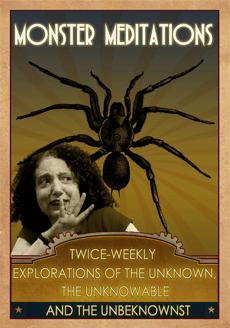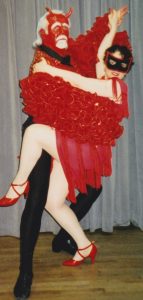Some actors put on a costume to get into character and children play dress up to explore being all sorts of people—from fairy tales princesses to sturdy adventurers. I have a photo of myself pretending to be a mountain climber. I took a baby doll sized stroller and strapped the frame around my shoulders. My teddy bear peeks out from inside the jerry-rigged backpack, and I’m holding a jump rope. I was about four and mountaineering in the living room!
I’m sure that some writers dress to get into the right mood to write about a particular character. I’ve yet to try it, but the idea is cool. Need to feel like Sherlock Holmes—put on a deerstalker hat. Getting inside the head of a femme fatale—try stiletto heels. So much of what brings a character to life is vested in their appearance. In real life, appearance attracts and rejects, explains and confuses, and, in general, makes people crazy.
As human animals we invest positive traits in those we find attractive and negative in those we deem unattractive, and yet experience teaches us that kindness, intelligence, generosity, altruism, the capacity to experience and share joy, and everything that is actually GOOD is not present solely in those with beautiful OUTSIDES.
Still, we get a great deal of specific information from appearance and writers use those descriptions to connect with readers. Describe a character as slovenly and their disheveled appearance indicates to the reader that they are likely to be sloppy and careless in other aspects of their life. Perhaps the stains on a sweater will become clues necessary for the solution of a mystery? But it’s also likely that the reader will get the message that this messy character leads a messy life. The character could be unreliable as well as untidy?
Appearance can illustrate what’s going on inside the character and it can also be a disguise—the pretty, sugar coating hiding a heinous personality. To write about that character, I might have to get myself a deerstalker!






lol – I learned the hard way that not all that giltters is gold. 🙂
In my own writing, I seem to have this thing about integrity. Kenneth could enhance the appearance of his avatar, but he doesn’t. When I wrote that tiny scene, I had no idea that it would trigger my deeper understanding of the character, or that he’d end up too honest for his own good.
Sadly, most of the really good looking men I’ve met in real life were…not like Kenneth. Thwarted wishfulfilment, clearly. 🙁
Those attractive candy-coatings get us every time!
I think our brains are programmed to go toward beautiful people, and yet the more we learn the more we know that the beauty is often “skin deep.’ Still, we keep on trying and heading toward the handsome fellow with the bedroom eyes. In your Innerspace saga, I liked Kenneth’s avatar choices and I found them intriguing as a clue to his character. Unlike our real bodies, over which we have some but not a great deal of control, an avatar can be an idealized version of ourselves. It’s interesting to see what people (and fictional characters) chose as their representative image.